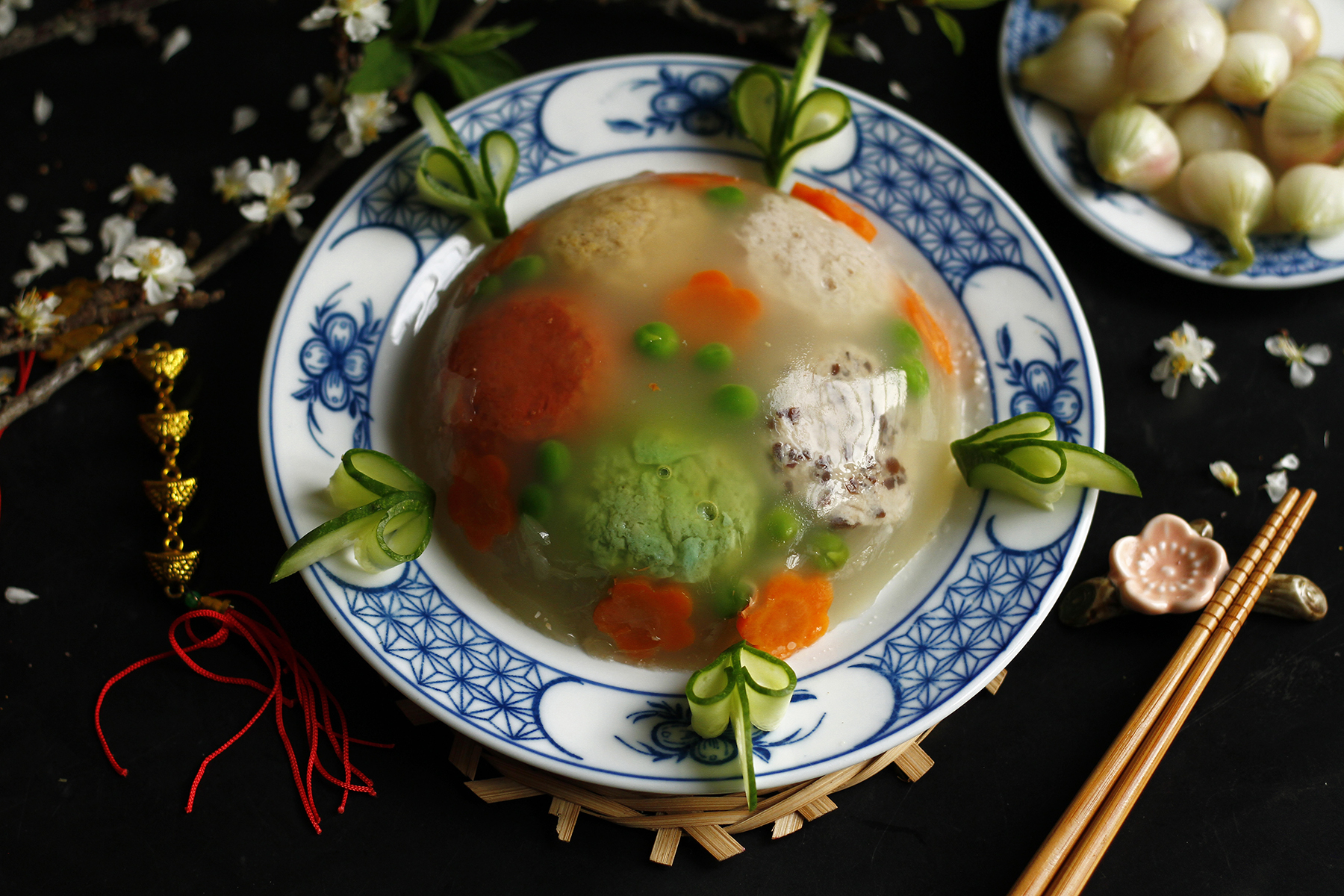It is not easy to cook a traditional Hanoi Tet meal with many strict requirements, even requiring many people to do it together. Talking to journalist Vu Thi Tuyet Nhung - who has many years of experience researching Hanoi cuisine, Travellive learned many interesting things: "To cook Tet dishes like in my mother's time, many brothers and sisters must gather together to make them. For example, a bowl of bun thang requires one person to omelet eggs, one person to pick vegetables, and one person to watch the pot of broth to finish it. But nowadays, it is very hard work."

Portrait of journalist Vu Thi Tuyet Nhung - a person with many years of research experience and a deep love for ancient Hanoi cuisine.
According to Ms. Vu Thi Tuyet Nhung, there are four special dishes that clearly represent the traditional Tet atmosphere in Hanoi and require many skills that not everyone can do correctly. Each dish will be eaten on the first day of the new year, bringing a full Tet.
Beautiful dark cloud growth
Moc Van Am is a dish that is somewhat similar to meat jelly because it also uses pork skin to make jelly, covering the ingredients inside. For many families, this dish is not really popular. However, in ancient times, this was a spring dish eaten on the first day of the year.
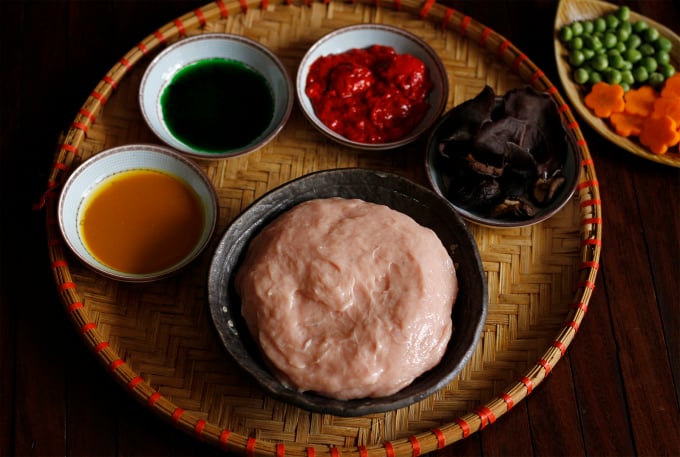
Dark Cloud Sprout is made from three simple ingredients.
According to Ms. Tuyet Nhung, her mother used three main ingredients to make Moc Van: "Nowadays, people always add carrots and peas, but in fact, only adding raw ham, pork skin and shiitake mushrooms will keep the dish for a long time and not lose its flavor."
First, the minced pork is ground very finely with the hot pork (the freshly cut part) and mixed well with fish sauce, pepper, wood ear mushrooms, and shiitake mushrooms. The housewife gently applies a little fat to the palm of her hand and forms them into small balls, places them in the steamer, and steams them with boiling water. After steaming, the meatballs must be put into the bone broth and the pork skin, and then filtered with fish sauce and salt.
Next, the good pork skin is rubbed to remove the hair, washed many times, then simmered in water until soft, then put the steamed meatballs in. Then put them in a bowl to solidify and then inverted onto a plate like meatballs. The pork skin is like a cloud covering the meatballs, so the dish is called cloud covered meatballs.
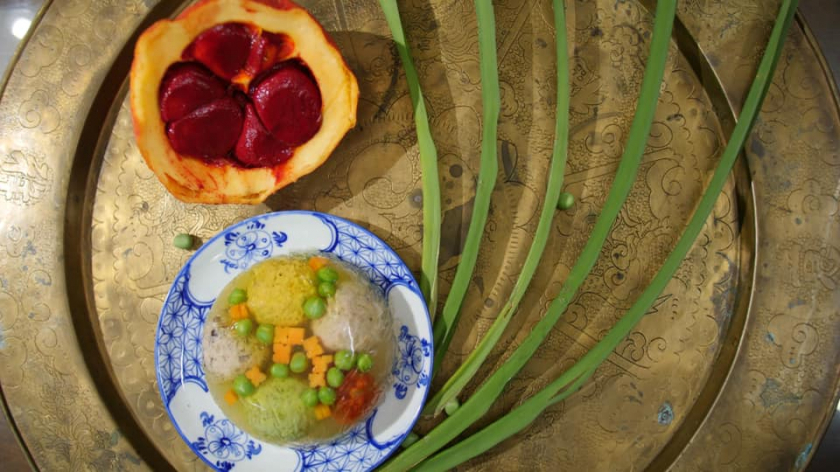
Beautiful finished product.
Shrimp rolls require meticulous hands
The traditional dish of freshwater shrimp rolls often appears on the Tet tray on the 3rd, 5th, 7th and 9th lunar days. According to Ms. Tuyet Nhung, this is the time to burn votive papers, people want to eat a dish that is refreshing, unique but still ensures adequate nutrition.
Each shrimp roll will include a shrimp, a piece of vermicelli, a sprig of herbs, Vietnamese coriander, cilantro, julienned omelet, and thinly sliced boiled meat. All are rolled with a piece of lettuce and tied with a stalk of boiled onion.
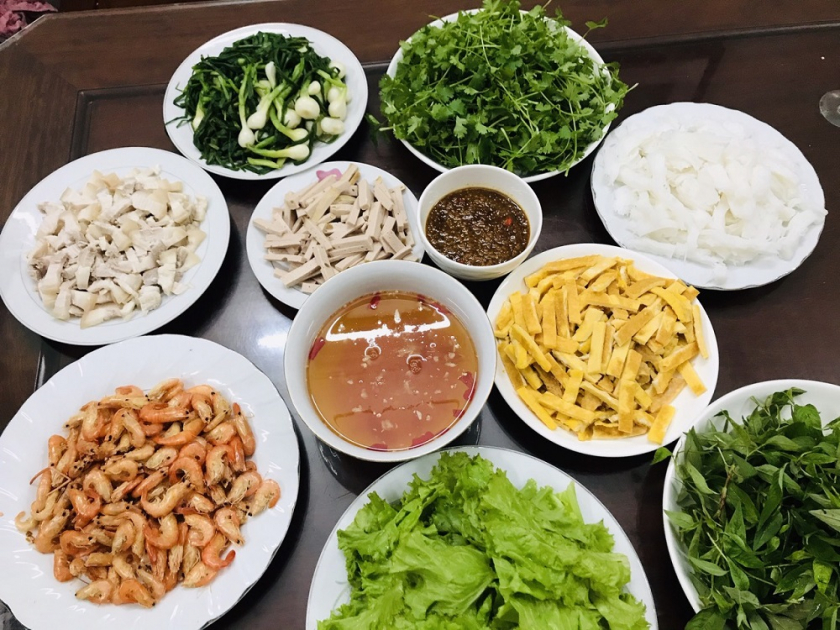
Shrimp rolls make Tet meal more fresh.
Like all other spring rolls, the dipping sauce is the soul, making the shrimp spring rolls special. Ms. Tuyet Nhung reveals the secret to making a delicious dipping sauce.
First, for every ladle of fish sauce, a ladle of vinegar and a ladle of sugar, then five ladles of water, add a few drops of water bug essential oil. If you use water bug, do not add pepper or garlic. The dipping sauce for the freshwater shrimp rolls cannot lack chili spice to create an attractive spicy flavor. Another special spice is vinegar with molasses. All of these create an unforgettable freshwater shrimp roll.
She added: "This dish requires meticulousness and skill because if not rolled properly, it will fall apart. But once rolled, the whole tray of food will be beautiful and radiant."
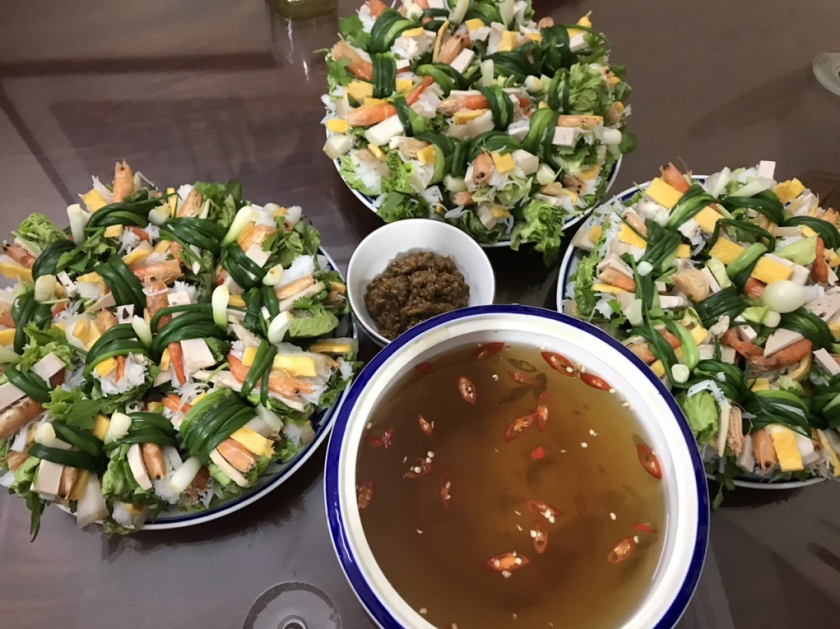
Shrimp spring rolls require meticulous hands and careful wrapping.
Fragrant Bun Thang
Many people usually eat Bun thang after the second day of Tet, when the whole family is tired of chicken and banh chung. Bun thang is a complicated dish to make and can only be cooked in a large family.
First, the cook uses dried shrimp (if not available, use shrimp instead), simmers with chicken bones, pork bones and a few pieces of grilled sugar cane. When cooking, we must watch the heat carefully so that the broth is clear. When the broth boils, immediately skim off the foam and reduce the heat.
For chicken, housewives choose capon or laying hen, boil it and filter the meat. Next, add carefully picked Vietnamese coriander. The vermicelli must be thin vermicelli noodles blanched in boiling water.
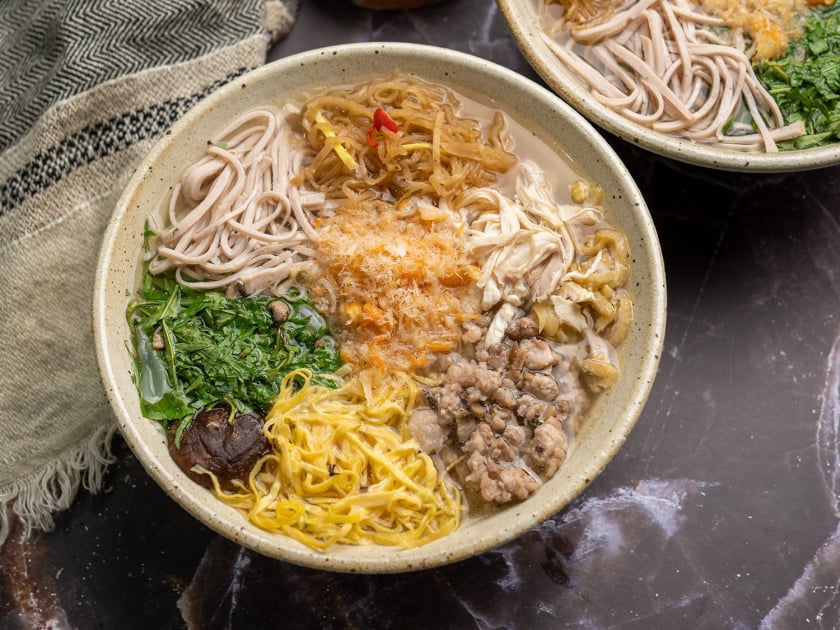
Bun thang needs many people to cook.
According to Ms. Tuyet Nhung, in the past, bun thang did not have onions and shiitake mushrooms, but now everyone has started to use it. For her, the most difficult step is to make egg omelets: "Making eggs for bun thang is not simple. Heat the pan slightly, apply a little lard and wipe it off. Beat the eggs quickly with white wine, salt and a little water, then pour them into the pan in small ladlefuls, spread them around the pan to form a thin round piece and flip it quickly, then remove from heat."
At the end, it was time for everyone to lend a hand. The omelet was sliced into thin strips, then each thinly sliced egg was placed on the plate. The shredded pork ham and pickled radish were also gradually arranged. People ladled the hot broth over the noodles and the cold ingredients in the bowl, scooped in a spoonful of shrimp paste and enjoyed. It was this last spoonful of shrimp paste that helped the seemingly separate ingredients blend together, awakening the taste buds that were bored with fish, meat, sticky rice...
In the old days, mothers-in-law often tested their daughters-in-law's skills with sliced omelets. Slicing skillfully and evenly. Bun thang was also eaten with some dried shrimp floss, creating an attractive and delicate flavor in the bowl of bun thang.
Stir-fried almonds for drinking party
Stir-fried almonds, a clever “anti-nausea” dish that our ancestors invented during Tet. Moreover, this is also a famous snack that any family in the past had on the dinner table during the first days of the year, happily drinking a glass of wine to celebrate.
"In the past, almonds were very precious, people often stir-fried them with peanuts, but now they just stir-fry almonds," - journalist Tuyet Nhung confided.

A plate of stir-fried almonds when beautifully presented is not inferior to any other Tet dish.
Almonds are fried with onions and fat, stir-fried separately with ingredients such as chicken gizzards, pork loin, kohlrabi, carrots, jicama and peas. After that, the cook carefully blanchs vegetables with chicken broth or bone broth and salt. Next, the plate of fried vegetables is fried with onions and fat until absorbed, then mixed with meat and almonds roasted with salt to taste, then tossed in fat. Mix everything together and scoop onto a plate, sprinkle with pepper and coriander. This is a precious drinking dish of the past with the harmony of vegetables and meat. The dish has a light, pleasant flavor, becoming a delicious appetizer with rice and wine, loved by both young and old in the family.
The four dishes above are not only the culinary quintessence of Hanoi wrapped in each bite, but also the pride of the skillful housewives of the past. In the past, mothers-in-law often tested their daughters-in-law with these four difficult “tests”.
So we know, there are always lavish feasts, but to create and summarize delicious, harmonious dishes with rich identity, we, the descendants, must also learn and contemplate the dishes of our ancestors. If you don't know what to make this Tet, Travellive invites you to the kitchen to show off your cooking skills with the dishes mentioned above!





